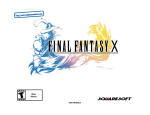Download Amazon electronics review: Samsung S425G Prepaid Phone 22 of
Transcript
Amazon electronics review: Samsung S425G Prepaid Phone
22 of 22 people found the following review helpful
The best TracFone for most people
I recently switched to Tracfone after learning that their "Triple Minutes For Life" phones make
them a better deal than their corporate cousin, Net10. For us light talkers, Net10's best plan
costs $15/month for 150 minutes, whereas Tracfone's Triple Minutes thing lets you get away
with paying $10/month for 120 minutes, which is only 8.3 cents per minute (and text messages
are 1/3rd of that). Heck, if you want to take minimalism to the breaking point, you can take it
down to $6.67/month for 60 minutes.
Anyway, over at Net10 I owned this phone's grandfather (Samsung T401G) and was content
with it; so far its descendant is looking just as good. It has a full load of stuff: 2MP camera,
MP3 player, video and voice recorders, Bluetooth, 32GB SD card slot, 4 programmable
shortcut keys, voice command, and its highlight, a tactile QWERTY keyboard that slides out
sideways. The display is nice, the menu layout logical and user-friendly, and the 416 MHz
processor keep things happening quickly enough. The camera takes decent pictures in well-lit
situations, too.
Annoyances: the shared headphone/charger jack is proprietary rather than MicroUSB (though
funny enough, Samsung's old proprietary charger doesn't fit, yet a new LG charger does). The
keyboard's fussy in some ways, i.e. the spacebar being half as big as it should be, the
apostrophe not having a dedicated key, and the need to aim for the exact center of the keys
themselves. The speaker for the ringer is on the back, which makes no sense. Finally,
Samsung should've let us disable the button for the browser (especially considering what a
piece of crap it is), since its permanent placement on the right-side softkey makes you prone to
butt-browsing and wasting minutes. Butt-dialing is also an issue if you don't lock the phone.
But all things considered, this S425G still seems like the phone that makes the best sense for
the most people. Tracfone's lower-end models are too bare-bones, and the direct competition
consists of the LG 800G (an annoying touchscreen phone), LG 840G (its replacement), LG
505C (appealing but $90), a Motorola EX124G that uses a stylus (WTF), and a couple of boxy
Blackberry-like phones, the Samsung S390G and LG 530G. Aside from the Samsungs that
this phone replaced (the T404G & R455C), I don't think anything else has Triple Minutes.
So yeah, if you want a good, mid-price phone that's basically good at everything but Internet,
this should do the job just fine.
Amazon electronics review: Onkyo TX-SR508 Home Theater Receiver
17 of 17 people found the following review helpful
Everything you need, nothing you don't
Onkyo receivers kick ass for a few fundamental reasons: their sound quality is at the top of the
game (beating boring-sounding Sonys and Yamahas, and only equaled by Pioneer), their
specs and features are competitive at every price point, they look good, and they have the best
ergonomics. That last point is pretty key to me, especially since receivers can seem like pretty
homogeneous and impenetrably complicated products to electronics rookies (there's at least
one in most households). Case in point: I like the button layout, menu logic, and intuitive
remote. I like how there are direct buttons for every input source on both the front panel AND
the remote (meaning you can just press a button marked "DVD" or "Tuner" instead of cycling
through them with a little knob). I like how the volume control was apparently designed by
humans (crank it up and it reads 10, 11, 12 instead of cryptically counting -35 dB, -34.5 dB, -34
dB). I even like Onkyo's green font, and anyone can appreciate a user's manual that's easy to
understand, as well as nice and skinny thanks to Onkyo's decision to put the Spanish/French
versions in a separate booklet.
None of this is news to me, having already owned the three-years-ago version of this model,
the 2007 TX-SR505. But I had to upgrade because it wasn't until last year's model (TX-SR507)
that Onkyo threw in two crucial updates: the ability to decode the new Blu-ray sound
standards, Dolby TrueHD and DTS Master Audio (which are superior to Dolby Digital 5.1 and
DTS 5.1, the Laserdisc/DVD standards that have been universal since the 90s) and
***REAL*** HDMI ports, instead of that "HDMI Pass-Through" crap that Onkyo had been
scamming us with for years (in case you missed it, HDMI Pass-Through required a
supplemental coaxial/optical audio connection, which was not only annoying but limiting, since
those audio cables lack the bandwidth to handle the aforementioned new sound formats).
Anyway, now that these features have trickled down to this "$400" model (heh, subtract about
160 by Amazon standards), the true Blu-ray experience can at last be enjoyed by the masses.
Thanks to this new toy, I just experienced high-definition sound for the first time, and let me tell
you, it sounds GRATE: clearer dialogue, punchier bass, and just more all-around aural
substance. There ain't nothin like uncompressed, lossless, 5.1-channel sound -- it's at least as
obvious as the difference between CDs and MP3s (same principle at work, too).
As far as comparing the TX-SR508 to the other receivers within Onkyo's overcrowded 8-man
lineup, I think this second-from-the-bottom model hits the price/features sweet spot for most
non-hardcore-geek folk. It only costs about $40 (in Amazon dollars) above the bottom-end TXSR308 yet adds all this good stuff:
-80 watts per channel vs. 65
-4 HDMI inputs vs. 3
-2 coaxial audio inputs vs. 1
-front panel composite inputs (the old school kind)
-higher-quality speaker connections (screw-down binding posts vs. cheap wire clips)
-7.1 channels vs. 5.1
-bi-amp capability for front speakers
-Dolby Pro Logic IIz (if you want to add 2 extra ceiling-mounted speakers)
-Audyssey Dynamic EQ & Audyssey Dynamic Volume (levels out the volume extremes)
-WRAT - Wide Range Amplifier Technology (whatever that means)
-"All-Discrete Circuitry" (say what?)
-192 KHz/24-Bit Video Digital Audio Converters
-Zone 2 (for powering speakers in another room)
-SIRIUS radio ready
-an auto setup microphone
On the other hand, the next-up model, the TX-SR608, costs a whopping 140 Amazon dollars
more to add:
-PC input
-6 HDMI inputs vs. 4
-second subwoofer input
-100 watts vs. 80
-THX certification (I think that just means it's "powerful enough" to drive THX-certified speakers
-- sounds like a THX branding circle-jerk)
-Faroudja DCDi video upconversion
-analog-to-HDMI conversion (magazines say this doesn't work well)
-3-Stage Inverted Darlington Circuitry (???)
Nice, but not necessary. Likewise, going even farther up the price scale seems to buy
superfluous amenities like excess wattage, hookups for 10 speakers (whatever marketers tell
you, 5.1 has been the only standard since the 90s and most movies today are still encoded
that way), and a few other pieces of non-essential technology.
So basically, in the wide world of audio-video receivers, Onkyo's the best brand and this is the
best Onkyo. What more do you need to know?
Amazon book review: Economics for the Rest of Us
7 of 7 people found the following review helpful
True to its title
For those who haven't been through a certain college curriculum, the subject of economics
is about "the allocation of scarce resources", and is basically a social science (like
psychology, sociology, and a bunch of other majors ending in "ology") with ten tons of
math unnaturally shoved where it doesn't belong. This book thankfully keeps the formulas
and graphs to a minimum, instead focusing on explaining and philosophizing about a few
key economic concepts. I thought it did so in a way that's pretty thoughtful and engaging,
with the welcome oversight of a social conscience.
The first, more interesting half of this sub-200-page book explores the concept of
economic efficiency, defining/debating stuff like Utilitarianism (which basically argues that
feeding the poor with the rich's money is a net good for society since a dollar means more
to the poor), Pareto efficiency (argues against that), supply and demand, taxes, and
income redistribution. It gets especially thought-provoking near the end, i.e. Chapter 7 gets
into how massive inequality can ruin society through consumption alone. How? Because it
becomes more rational/profitable for sellers to cater to only a tiny handful of super-rich
instead of masses of average people, which leads to consequences like a dearth of real
estate in NYC (because the rich demand space-hogging mega apartments), airplanes with
no legroom, lower availability of doctors and medicines, and even crappier rock concerts
(cuz some CEO just hands Elton John a million to show up at his house instead). He also
argues against popular notions like higher taxes discouraging CEOs to work or rent control
hurting the real estate market, and expends lots of effort discrediting Pareto in general.
The second half is about wages and employment, exploring things like the Value of
Marginal Product, how CEOs get away with earning $11,000,000 on average (answer:
because the loss to each shareholder is too small for any of them to care, and because of
the inherent difficulty in technically proving that the CEO didn't actually contribute that
much value, even though everyone knows it), how minimum wages don't hurt the
economy, and how lowering taxes doesn't help it. All the while, he reminds us that the
economy does NOT have a self-correcting mechanism in times of failure, and that there's
really no such thing as "the economy" anyway -- which can be empirically robust even
when most of the people in it are just scraping by. If you're sensing that this Moshe Adler
guy's a Democrat, you'd be right (he even slips in a jab at creationism on the last page,
heh heh), but I thought his arguments were pretty convincing, even if I occasionally got lost
in his hypothetical examples.
Pick this up if you're interested in an econ book that won't put you to sleep.
Amazon book review: Everything You Always Wanted to Know About Sex But Were Afraid
to Ask
4 of 4 people found the following review helpful
Not worthy of its subject matter
Wow, lots of hate coming from the generation that grew up with this book, and the LGBT
community! Well for what it's worth, I'm pretty young and pretty straight, and while I don't
see what all the hubbub's about, I didn't find much more to admire than the rest of y'all.
For one thing, at this point a better title might be "Everything you already knew about sex."
As far as the stuff in the book that's actually true, I would guess that anyone born after
1970 already knows 70% of it before finishing high school -- the bulk of it from 7th grade
science, with general knowledge and common teenage talk filling in the rest. The book
makes a pretty mediocre first impression, too, spending its first seven pages talking about
dick size (har har). It's done in the most banal way possible, too, wasting space to
philosophize about questions like how to make it look bigger ("trim your pubes" -- blinding
insight there, guy!) or that porn stars aren't really as well-endowed as they claim. Finally,
this Reuben guy's not much of a writer. He's short on style and wit, doesn't offer much
depth in his discussions on anything, and I saw no trace of successful humor, despite an
announcement in the Introduction self-declaring how funny he is. His only real
accomplishment -- aside from polluting the narrative with ten tons of irrelevant Bible quotes
-- was managing to make sex boring.
As for the alleged anti-gay sentiments, well, this guy probably is a homophobe, if for no
other reason than his religious nutjob nature (he also "hates porn"). But honestly, unless I
just missed it from reading too fast, I didn't really sense bigotry in this revised 1999 edition,
aside from maybe his over-associating gayness with anonymous bathroom sex and what
he wrongheadedly classifies as "sexual perversion" (S&M, BDSM, and the like). As far as
gay people being promiscuous, I wouldn't necessarily call that assumption offensive; just
dumb and uneducated. Here's a more accurate generalization: MEN are on average more
promiscuous than WOMEN, and thus it follows that gay men would engage in more
promiscuity than straight men ***because their partners are more accepting of the idea***,
not because of gayness. (Said another way, men like to screw around, so in a community
consisting of men with the the same preference, you can expect to see a lot of screwing
around.) I'd only call the "gay=promiscuous" thing bigoted in that it entirely ignores
lesbians, who have the opposite preference since they're women. Attitudes about sex and
relationships differ by gender far more than by sexual orientation.
Anyway, find something better to read.
Amazon book review: Should You Really Be A Lawyer? The Guide To Smart Career
Choices Before, During & After Law School
7 of 7 people found the following review helpful
Of no help in answering its question
Exhaustion made me quit this book halfway, but that's more than enough reading to
discover that its authors have embarrassingly little to say about the legal profession
beyond the obvious. The first three chapters can be summed up in a sentence: don't go
to law school for the wrong reasons, because it's expensive. That's a fine notion, but
rather than explore the issue in any meaningful way, they just dish out banal pop culture
references, TV & movie quotes, generic anecdotes that go nowhere, and a whole lot of
repetition. Making matters worse, they smack down a big glossary of psychobabble
terminology early on (i.e. "confirmation bias", "decision paralysis", "information
cascade"), then refer to the terms constantly in a misguided attempt to sound intelligent
and scientific.
Check out this passage from page 9:
"Deborah was obsessed with getting a graduate degree by 30, an arbitrarily chosen age
that took on far too much significance in her decision-making. This common trap is
called ANCHORING -- attaching great importance to a fact or figure that may have little
or no bearing on our judgments or decisions.
When she decided to stay in law school, Deborah was influenced by her fear that she
might later regret her decision to leave. Again, this is another powerful force called
REGRET AVERSION, which means that people tend to shy away from taking an action
because they fear they'll regret making their decision later. Like a lot of CHOICE
CHALLENGES, the practice of making decisions based on fear of regret sounds
obvious when you hear it explained, but the extent to which this tendency affects your
decisions is greater than most people think.
Deborah was also overwhelmed by the thought of how to decide what to do if she left
law school. This reflects a common CHOICE CHALLENGE called DECISION
PARALYSIS -- a reference to the difficulty people encounter when having to select from
many options. For Deborah, ruling out law ruled in everything else, and the thought of
choosing among all those professional paths was too daunting."
Isn't it scary how so many words can contain so little information?
Second example (page 65):
"If you don't like using the skills that most lawyers use, you probably won't enjoy being a
lawyer. If you dislike thinking about legal subjects and reading legal documents, it
doesn't bode well for your happiness in law. It's better to find out before starting school
whether you would enjoy working in a legal environment, and whether legal work is in
line with your priorities. If you don't consider these questions now, you may wind up
confronting them later when the stakes are higher -- after you've invested three years
and a ton of money on a JD."
There's also a section headlined "What Psychological Experience Can I Expect From
Law School?", whose given answers are the following (and I quote):
1. Read about it
2. Talk to law students and law school counselors about common stressors
3. Try it out
Seriously.
In sum, this is a cheaply conceived, badly written, and sloppily edited hybrid between a
third-rate career book and a fourth-rate psychology book from two morons who show no
indication of having ever been lawyers.
Amazon video game review: Donkey Kong Country Returns
4 of 4 people found the following review helpful
A worthy remake, though hard
Until recently, those of us who grew up on (and loved) 2D side-scrolling platform games
had been suffering a 15-year starvation. The rather awesome reincarnation of New
Super Mario Brothers Wii put an end to that in 2009, while this year we get a restoring
of the other most beloved game of the genre, Donkey Kong Country (yes, more
beloved, and better, than any Sonic). Like NSMB, Donkey Kong Country Returns strikes
me as a faithful sequel that's about 90% as good as the original.
The original was clearly the directive for this game's design. While a different company
did the development work this time (Retro Studios, filling in for Rare), most of the
characters, level themes, and creatures were borrowed from past games, and every
song from the first game's awesome soundtrack was lifted almost verbatim. As a
traditional platformer, this is very much a running & jumping affair, with a smorgasbord
of bonus items littered throughout the levels: collect 100 bananas and get a 1UP; collect
coins to buy power-ups and extra lives from Cranky Kong's Store; find the letters K O N
G to unlock hidden levels; and find the puzzle pieces in every level for the heck of it.
Rambi the Rhino makes a return on a few levels, letting you ride him and ram your way
through the course for a fun change of pace (sadly, the frog and dolphin are no-shows).
Here are the main differences compared to DKC:
-Diddy don't do diddly. Except for the new 2-player cooperative mode, you now only
control Donkey Kong; Diddy Kong has basically been demoted to a piece of luggage on
your back that provides two extra life hearts, plus a jetpack that lets you hover for about
two seconds and land with a greater degree of control (kind of like the cape in Super
Mario World).
-To utilize the better graphics, the creators gave a nod to modern times by incorporating
some semi-3D elements: the background drawings are in 3D (occasionally causing
some confusion as to what objects are tangible), and on some levels you transport over
via barrel cannon to the far distance of the level.
-Because this is the Wii, some of the controls are retarded, forcing arm waggling to pull
off normal moves like rolling, blowing, and ground-pounding. On top of being an
annoying waste of energy, it occasionally screws with your precision and causes
needless deaths. This game would have been an ideal candidate for Classic Controller
support (which also would've solved the issue of the Wiimote being uncomfortable to
hold sideways), but Nintendo offers no such option.
-This game is way mother****in harder than DKC. I'm probably one of the better gamers
out there, but by the end of World 8 (there's an unlockable bonus World 9) I'd died at
least 100 times. Some of the deaths seem kind of cheap and unfair too, requiring some
godlike combination of cat-quick reflexes and super-high precision to get right the first
time -- basically, think of the hardest Mine Cart level from DKC and picture 40 more of
those. Success seems to depend on trial/error and memorization as much as actual
gaming skill. I do think the level design reflects a lot of smarts and creativity, but the
original DKC managed to provide a more reasonable level of challenge while also
feeling more inspired.
Like I said, 90% as good. But remember that the original might still be the best
platformer EVAR, so that's a pretty good showing. I'm still glad I bought it, and I'm sure
you'll have fun.
Video game review: Final Fantasy XI (2003)
Mergers have been all over the news. Sometimes they work, such as for the
Chrysler Crossfire owner upon discovery that his new $35K ride is actually a $50K
Mercedes SLK in disguise. Sometimes they don't: AOL Time Warner, enough said.
The latest conjunction to rock our common consumer lives come courtesy of Square
Enix, father of Final Fantasy, and this time, we're getting three mergers for the price of
one. SquEnix's latest entry in the series joins Final Fantasy with the online world, PC
platforms with PS2s, and Japan's gamers with ours.
This Final Fantasy becomes reality one step at a time. First to make the
transition was Japan, who has been thumbing away since mid-2002. Next on the list
were American PC gamers, who got their first taste during the final days of October.
Last in line are the poor PlayStation 2 plebeians, who will be tapping their feet in
anticipation until March 2004. (But then, anyone used to 300 MHz has surely
accumulated some patience.)
To prepare yourself, promptly disregard all pre-existing knowledge you had about
Final Fantasy; most of what you know doesn't apply here. This is only a Final Fantasy
in name (and perhaps in theme); the gameplay differs as much as it did between Super
Mario 1 and 2. Next, quit your job, so you can say you did so at will. As you know,
firings scar the résumé. If you have a significant other, make a clean break; such is less
painful than a relationship deteriorated through neglect. Program Round Table Pizza
onto your speed dial, and given FFXI's lack of a pause button, try acquiring a chair
similar to Homer Simpson's recliner-toilet invention. I'm giving you this advice because,
in MMORPG tradition, you'll never want to leave your seat, so you might as well be
comfortable.
So, it's that good? In a word, yes. As an average Joe whose most recent video
game mastery was of Street Fighter II, I'm not the type easily sucked into the gaming
universe. Heck, I only picked the game up because of my job as a software tester, and
Final Fantasy XI sure isn't the most inviting game from the get-go.
Starting out, the game offered more freedom than I knew what to do with.
Choosing a character first entails picking among one of five races: elf-like Elvaans, catlike Mithras, little kid Tarutarus, bulky Galkans, and humanoid Humans. Then you
choose your gender (not an option for male-only Galkans and female-only Mithras), and
finally, your job: Warrior, Monk, Thief, Black Mage, White Mage, Red Mage.
Regarding the races, let appearances be your guide. Galkans can take quite a
pounding, Tarutarus get flattened like squirrels on the freeway, with humans exactly
average and the rest at various points between the extremes. As far as jobs go, Mages
are magic users -- Black mages use harmful magic, Whites heal and defend, while
Reds do a bit of both. Picking a proper combination is a strategic decision: aggressive
types might try a Galkan Warrior to pound every forest creature into submission;
practical types would lean towards a well-balanced Red Mage Human. After deciding
on an identity (jobs can be changed later; races cannot), you must choose between
three vast nations: San d'Oria, Windurst, or Bastok.
The impression continues. You start off in town, but this "town" seems like a
Bigger Apple than New York in both size and density. Visit every room and talk to all
townspeople and watch three hours vanish from your life. Your character "runs" at a
pedestrian's pace, and many of the NPC conversations consist of irrelevant babbling,
telling you little of value. I know Square was aiming for realism with FFXI, but was vapid
conversation really one of real life's must-haves? The slow-scrolling text doesn't help
much either, but chatting with townspeople is the only way to get assigned quests and
missions (and the exclusive items that come as rewards) needed to advance in the
game.
Things don't get interesting until you finally venture outside the town. The first
thing you'll probably see is a cute wittle rabbit. KILL! Navigating through your enigmatic
control menus, you eventually learn to position your cursor over the critter and select
"attack." There isn't much reason to get involved, since the fight is automated. Punch.
Whack. Punch. Whack. Punch. Miss. Whack. Punch. Ho-hum. I win. Yay, free gil
(money).
Next to this fresh hare carcass, you find a tunnel worm. TIME TO DIE! "Seems
like easy prey," says your reading. After sitting through another automated animated
fist fight, your next victory comes. Noticing your low energy reading, you recharge by
sitting down for about two minutes while staring impatiently at the screen. Then you
decide to wander farther from town and find another creature, perhaps a Goblin Thug.
"Seems like an even match" says your reading. Feeling lucky, you attack. The fight
lasts about 30 seconds, and then boom, instant humility. You barely scratched the guy,
as he remains standing with nearly half life. You call that an even match?? Feeling
slightly irked by your early death, which teleports you all the way back to town, you
venture out a second time. Minding your own business, you hear a loud THUD -- you're
being attacked! Your gauge says "even match" but you're not falling for that again. You
try to escape, running at full speed in the opposite direction, but the monster's attacks,
in spite of being animated punches, seem to have an army tank's range. After a futile
struggle, you die again, positively pissed.
But maybe after an hour or two of trial and error (mostly error), eventually it
comes: "LEVEL UP!" Instant HP boost, instant MP boost, with trademark Final Fantasy
jingle music symbolizing your achievement. Another hour later, another LEVEL UP!,
with more raises and perhaps a new spell. What a feeling! Over the next few days, you
gradually gain a feel for timing, levels of damage done to/from certain enemies, which
areas on the (vast) map are safe, and how to ration your magic spells so you're not left
empty-handed. It's also at this point that the controller layout finally begins to sink into
your subconscious, so deaths no longer result from panicky button-pushing. After a
time, the LEVEL UPs get rarer: level 5 takes perhaps two hours, level 6, maybe three.
But you feel compelled to reach them.
And what begins a fun solo session turns into a party when you come across
other players and team up. It's best to have a team of specialized characters -- maybe
equal parts fighters, magicians, and healers -- so your talents complement each other's.
With your newfound alliance, you learn to take on bigger and badder things, and the
sense of adventure increases proportionally. Together, you learn to coordinate your
attacks to form Chain Spells (an attack greater than the sum of its parts) that give you a
fighting chance against the local bosses, and when you win, oh, what a rush. 100
experience points! 100 gil! More points on my scoreboard. Bring on the next. There's
a whole world to explore, and now you have friends to do it with.
Attacking and leveling may be the main course, but there are other attractions.
There's also completing quests (which never seem to stop), learning magic spells,
acquiring items, learning crafting skills (to make your own items), and making money
(now that's realism). After enough leveling up, new abilities emerge: riding chocobos
(Final Fantasy-speak for "ten-foot-tall chickens"), crossing into other nations, reviving
the dead, etc. After some point, whether you notice it or not, FFXI starts fulfilling two
essential human needs: a sense of accomplishment and a sense of human
relationships. Okay, so the replacements are surrogates, but it's all the same as far as
your emotions can tell, and feels just as involving. Two days of this game were
frustrating. Two weeks and you're hooked.
Of course, as with real life, this virtual one has some built-in frustrations. One
expands on my earlier gripes about the gigantic towns and babbling townspeople: it
takes an eternity to do a great many things. It's not just HP, MP, and magic that need
leveling up; absolutely EVERY physical ability can be improved, and each of them starts
at near-zero levels. If you plan to go fishing, plan on buying a lot of bait, and bring a
book; it can take an hour to catch your first fish. A step up on the irritation ladder is the
attention to detail needed for simple tasks like growing a plant. The Final Fantasy world
has a real-time clock ticking, and like a real plant, you must come back once every few
hours to pour water in that freakin pot of dirt. Suggestion to Square: make the battle
sequences active; automate the plant-growing!
Just about everything imaginable can be improved except running speed, and
since your character runs at what seems to be three miles per hour, a virtual crosstraining program wouldn't hurt. Lastly, depending on your idea of what constitutes cute,
the Tarutaru characters are sure to drive any non-preadolescent-girl insane. After about
an hour of talking to these frolicky, kid-like characters with names like Ranpi-Monpi who
speak in the style of "whattaru are those creepy-weepy goblin-woblins doing-woing?!?"
you want to drop-kick the little S.O.B. into the next village.
By far the worst aspect of the game -- and there is no disagreement on this -- is
the death penalty. Dying at level 5 or above results in a 10% deduction of whatever
experience points are needed to attain the next level. (Example: if you're at level 10
and need 3,000 XP to reach level 11, dying knocks you down 300.) This is as
frustrating as it is time-consuming, especially when the death seems undeserved, such
as when a misleading difficulty reading is to blame, or when the Internet connection
stalls and locks out controller input. Depending on how far along you are in the game,
one death can sabotage several hours of hard work, and three deaths in a day can
equal a day wasted. Knowing how common deaths are in the earlier stages of the
game (when people are still learning how to play), the severity of the penalty might
discourage a lot of reasonably patient players.
Then again, to pick up this game at all is admittance of having far too much time
on your hands to begin with, so perhaps it's of little consequence. Remember the good
old days of 1997 (Final Fantasy VII) when people complained about a 50-hour RPG?
Well, how does 500 sound? I played about 200 hours worth and achieved level 20.
Keeping in mind that level 65 is possible and that each level takes significantly longer to
reach than the preceding one, even 5,000 sounds optimistic.
To repeat, this game is to be avoided by anyone with a life, because FFXI just
might take its place. However, if you have none to begin with, it sure makes one heck
of a substitute. So if you fit the latter profile, make room on your shelf next to that copy
of EverCrack, because there's a new interactive opiate in town.
























![Echo27 [ENG].docx](http://vs1.manualzilla.com/store/data/005976885_1-e0af01262414116599497eec32cd1fc5-150x150.png)









